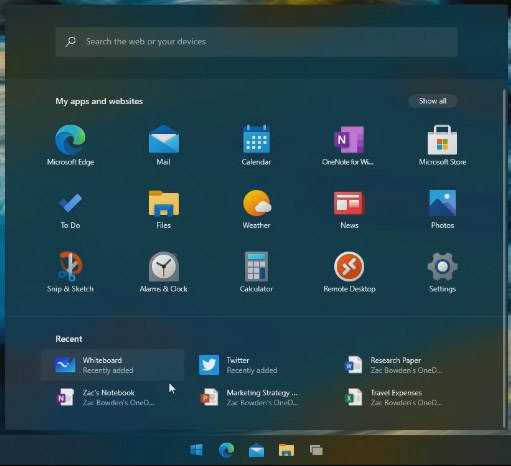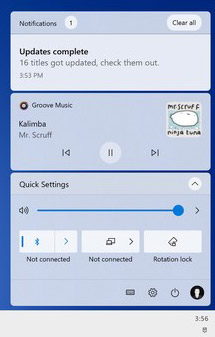Windows 10X from Microsoft is currently an actual response to Chrome OS
 Following quite a while of pausing, Microsoft presented a genuine response to Chrome OS. Another and almost final form of Windows 10X has spilled out. It offers a first glance at Microsoft's progressions to the impending working framework to prepare it for PCs. Windows 10X previously had going life as a variation of Windows 10 intended for double screen gadgets. It should have launched close by Microsoft's Surface Neo, a tablet-like device with two separate nine-inch shows overlay out to an entire 13-inch workspace.
Following quite a while of pausing, Microsoft presented a genuine response to Chrome OS. Another and almost final form of Windows 10X has spilled out. It offers a first glance at Microsoft's progressions to the impending working framework to prepare it for PCs. Windows 10X previously had going life as a variation of Windows 10 intended for double screen gadgets. It should have launched close by Microsoft's Surface Neo, a tablet-like device with two separate nine-inch shows overlay out to an entire 13-inch workspace.
Microsoft uncovered in 2020 that Windows 10X is presently being modified for "single-screen" gadgets like workstations, and Surface Neo has been deferred. While the organization has gone through years separating Windows 10X for foldable and double screen equipment, it presently looks and feels more like Chrome OS than any other time.
The most recent form that has spilled is a close last type of what will deliver on Chromebook-like gadgets not long from now. Windows 10X is anything but a working framework you will move up to or an update that will show up for existing machines. It will only be installed on new equipment, and it's a lightweight edition of Windows intended for the individuals who may be enticed to purchase a Chromebook, all things being equal.
Windows 10X previously looked a little Chrome OS-like on double screen gadgets, yet it's considerably more evident since it's intended for single-screen devices, all things being equal. Microsoft has disentangled pretty much every aspect of Windows within Windows 10X, to where it seems like a gateway to the web instead of an entrance to Windows applications.
The Start button is currently placed at the taskbar's center, with a Start menu that performs as a launcher. It lacks the Live Tiles feature that is available on Windows 10; all things considered, rather applications and recent docs are listed. You can look for applications, records, or even any content on the web through Bing, courtesy of Microsoft in web searching.
The correlations with Chrome OS are promptly evident here, with a launcher and web applications' attention. PWAs (Progressive Web Apps) can be installed to the Edge Browser, a Chromium-based browser from Microsoft. Those PWAs are pinnable to the taskbar.
 This Windows 10X taskbar is additionally a zone of the OS that has been dramatically rearranged. You may be accustomed to seeing system tray icons from applications, yet these are not available in Windows 10X. On the contrary, there's a straightforward Action Center that shows the time and jumps out to uncover quick settings like turning off a PC, using a VPN, connecting multiple displays, or controlling the volume. Action Center also contains notifications and an updated widget. You can manage your media playback with that widget.
This Windows 10X taskbar is additionally a zone of the OS that has been dramatically rearranged. You may be accustomed to seeing system tray icons from applications, yet these are not available in Windows 10X. On the contrary, there's a straightforward Action Center that shows the time and jumps out to uncover quick settings like turning off a PC, using a VPN, connecting multiple displays, or controlling the volume. Action Center also contains notifications and an updated widget. You can manage your media playback with that widget.
Compared to Windows 10, windowing became simpler in Windows 10X. You can drag and drop applications to run them one next to the other; however, they still cannot freely resize. Therefore, Maximize/Restore down button you are familiar with has been taken out in 10X. You can basically limit applications or close them here. You can still use multitasking with a gesture trackpad with the notebooks that come pre-installed with Windows 10X.
Microsoft has likewise been chipping away at a cutting-edge adaptation of File Explorer in Windows 10X. Accessing OneDrive cloud files is in focus. Managing downloaded files or files from the USB storage is still possible while you cannot access local files with Windows 10X. This edition of Windows 10 is concentrated on cloud storage.
It is supposed that Windows 10X will not be able to run native desktop software at the beginning. There is, however, a container technology, virtual machine like Sandbox from Windows 10, which lets running desktop software. That technology was developed to make sure that apps are compatible with dual screens. The compatibility is mainly checked by ensuring that the battery is not drained faster and how apps are displayed on the second screen.
That container technology is still in development because it is only available while only using developer mode. Also, you need the latest 10X version. You can infer from this that end users will not have an opportunity to use executable apps when they get a gadget with Windows 10X. No matter what, the Redmond-based tech giant is determined to combine Microsoft Store and web apps in Windows 10X.
To some extent, it seems like these all altercations in Windows 10X UI/UX will probably come to Windows 10 sometime this year. Microsoft has a plan to start "sweeping visual rejuvenation of Windows." This will modernize the Start menu, File Explorer, and built-in apps, giving the feeling of consistency in the overall usage of Windows 10.
Microsoft has yet to announce the launch date of the Windows 10X. Heck, we don't even names of the laptop producers that will get this OS edition. It's obvious this is a more precise shot to challenge Chromebooks after Microsoft has pursued for quite a long time. We still remember the Windows 10S edition, which put Microsoft in an awkward position with a failure. All we remember from that is S mode. Conversely, Windows 10X feels like a lot greater attention to reproduce the ease of Chrome OS. Don't forget about the benefits brought by the services and apps from Microsoft.
Continue reading about Technologies